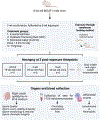In vivo exposure to electronic waste (e-waste) leachate and hydraulic fracturing fluid adversely impacts the male reproductive system
- PMID: 38160783
- PMCID: PMC10922462
- DOI: 10.1016/j.reprotox.2023.108533
In vivo exposure to electronic waste (e-waste) leachate and hydraulic fracturing fluid adversely impacts the male reproductive system
Abstract
Human health effects can arise from unregulated manual disassembly of electronic waste (e-waste) and/or hydraulic fracturing fluid spills. There is limited literature on the effects of e-waste and hydraulic fracturing wastewater exposure on the male reproductive system. Thus, this proof-of-concept study begins to address the question of how wastewater from two potentially hazardous environmental processes could affect sperm quality. Therefore, three groups of eight-week-old adult mice were exposed (5 d/wk for 6 wks) via a mealworm (Tenebrio molitor and Zophabas morio) feeding route to either: (1) e-waste leachate (50% dilution) from the Alaba Market (Lagos, Nigeria); (2) West Virginia hydraulic fracturing flowback (HFF) fluid (50% dilution); or, (3) deionized water (control). At 24-hours (hr), 3 weeks (wk), or 9-wk following the 6-wk exposure period, cohorts of mice were necropsied and adverse effects/persistence on the male reproductive system were examined. Ingestion of e-waste leachate or HFF fluid decreased number and concentration of sperm and increased both chromatin damage and numbers of morphological abnormalities in the sperm when compared to control mice. Levels of serum testosterone were reduced post-exposure (3- and 9-wk) in mice exposed to e-waste leachate and HFF when compared to time-matched controls, indicating the long-term persistence of adverse effects, well after the end of exposure. These data suggest that men living around or working in vicinity of either e-waste or hydraulic fracturing could face harmful effects to their reproductive health. From both a human health and economic standpoint, development of prevention and intervention strategies that are culturally relevant and economically sensitive are critically needed to reduce exposure to e-waste and HFF-associated toxic contaminants.
Keywords: Electronic waste; Hydraulic fracturing; Hydrofracturing, male reproductive health.
Copyright © 2024 Elsevier Inc. All rights reserved.
Conflict of interest statement
Declaration of Competing Interest The authors declare the following financial interests/personal relationships which may be considered as potential competing interests: Judith T. Zelikoff reports financial support was provided by NIEHS.
Figures







Similar articles
-
Cardio-respirometry disruption in zebrafish (Danio rerio) embryos exposed to hydraulic fracturing flowback and produced water.Environ Pollut. 2017 Dec;231(Pt 2):1477-1487. doi: 10.1016/j.envpol.2017.09.011. Epub 2017 Sep 18. Environ Pollut. 2017. PMID: 28928018
-
Algal treatment of wastewater generated during oil and gas production using hydraulic fracturing technology.Environ Technol. 2019 Mar;40(8):1027-1034. doi: 10.1080/09593330.2017.1415983. Epub 2017 Dec 19. Environ Technol. 2019. PMID: 29226768
-
Potential impact of flowback water from hydraulic fracturing on agricultural soil quality: Metal/metalloid bioaccessibility, Microtox bioassay, and enzyme activities.Sci Total Environ. 2017 Feb 1;579:1419-1426. doi: 10.1016/j.scitotenv.2016.11.141. Epub 2016 Nov 29. Sci Total Environ. 2017. PMID: 27913018
-
Investigating the Potential Toxicity of Hydraulic Fracturing Flowback and Produced Water Spills to Aquatic Animals in Freshwater Environments: A North American Perspective.Rev Environ Contam Toxicol. 2021;254:1-56. doi: 10.1007/398_2020_43. Rev Environ Contam Toxicol. 2021. PMID: 32318824 Review.
-
The Minderoo-Monaco Commission on Plastics and Human Health.Ann Glob Health. 2023 Mar 21;89(1):23. doi: 10.5334/aogh.4056. eCollection 2023. Ann Glob Health. 2023. PMID: 36969097 Free PMC article. Review.
References
-
- Paladini S, George S, Introduction: Sustainable economy and emerging markets, Sustainable Economy and Emerging Markets, Routledge; 2019, pp. 1–10.
-
- Bel G, Van Brunschot, Carolien, Easen N, Gray V, Kuehr R, Milios A, Mylvakanam I, Pennington J, A New Circular Vision for Electronics: Time for a Global Reboot, The E-waste Coalition, The E-waste Coalition, The E-waste Coalition, 2019.
-
- Balabanič D, Rupnik M, Klemenčič AK, Negative impact of endocrine-disrupting compounds on human reproductive health, Reproduction, Fertility and Development 23(3) (2011) 403–416. - PubMed
-
- McDermott-Levy R, Kaktins N, Sattler B, Fracking, the environment, and health, AJN The American Journal of Nursing 113(6) (2013) 45–51. - PubMed
-
- Avenbuan ON, Meltzer GY, Awada C, Raja A, Holian A, Zelikoff JT, A contemporary review of electronic waste through the lens of inhalation toxicology, Inhalation Toxicology 33(9–14) (2021) 285–294. - PubMed
MeSH terms
Substances
Grants and funding
LinkOut - more resources
Full Text Sources

